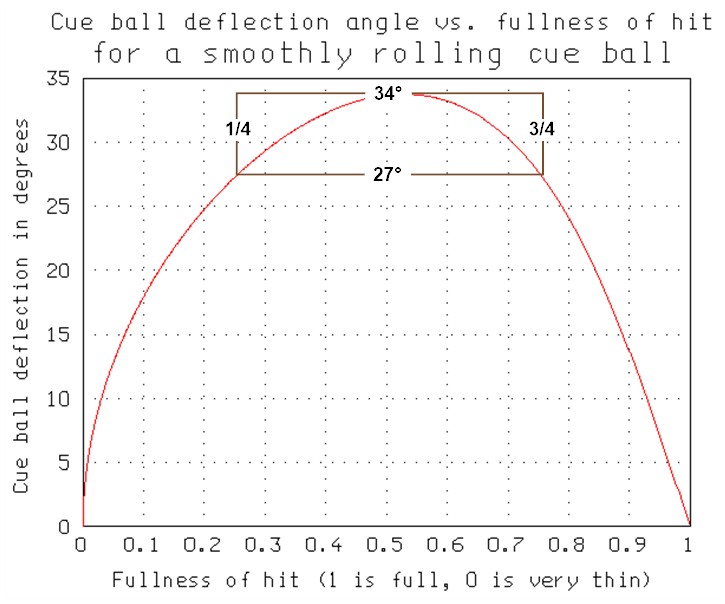What is the 30° rule?
The 30° rule states that for a rolling-CB shot, over a wide range of cut angles, between a 1/4-ball hit (49 degree cut) and 3/4-ball hit (14 degree cut), the CB will deflect or carom off by very close to 30° (the “natural angle“) from its original direction after hitting the OB. If you want to be more precise, the angle is a little more (about 34°) closer to a 1/2-ball hit and a little less (about 27°) closer to a 1/4-ball or 3/4-ball hit. The rule is described and illustrated in the following videos:
The Dr. Dave peace-sign technique is very useful in applying the 30° rule. The 30° rule angle templates can be useful to help you calibrate your V-sign. If you want to know how the CB path varies with speed and how to account for this, see speed effects. And if you want to see how numbers change a little with typical pool equipment conditions, see “Rolling Cue Ball Deflection Angle Approximations” (BD, November, 2011).
Here a video demonstrations showing examples of how the 30° rule can be used in different shot situations:
and here are some others:
- NV 3.7 – Using the 90° rule to check for and prevent a scratch
- NV 3.10 – Using the 30° rule to check for and prevent a scratch
- NV 5.1 – Using speed and angle-control to pocket a three-ball sequence
- NV 5.2 – Using speed and angle-control to pocket another three-ball sequence
- NV 7.2 – Cue ball billiard shot
- NV 7.3 – Object ball kiss shot
- NV 7.4 – 30° rule billiard shot
- NV B.43 – CB position control stun, roll, and draw reference lines
- NV B.46 – CB path scratch avoid, cluster break-out, and carom examples
Here’s a convenient 1-page summary resource page summarizing all of the important points of the 30° rule, and here’s a useful handout covering advanced topics.
For more info, see “The 30° rule: Part I – the basics” (BD, April, 2004) and where the CB goes for different cases.
See also: using inside spin to narrow the follow angle.
Is the 30° rule exact?
30° is an approximate carom angle that works fairly well over a wide range of cuts between a 1/4-ball and 3/4-ball hit. However, the carom angle over this range based on the equations and plots here:
TP B.13 – Rolling cue ball carom angle approximations
An improved approximation is to use a slightly larger angle (34°) closer to a 1/2-ball hit and a slightly small angle (about 27°) closer to a 1/4-ball or 3/4-ball hit. For more information, see the peace-sign technique and the following video:
Here’s a graph from Bob Jewett (with the approximation lines added by Pat Johnson) that show how the carom angle changes with ball-hit fraction:

Here’s a good demonstration from Pubo Huang showing how the deflected CB angle varies with cut angle:
Dr. Dave keeps this site commercial free, with no ads. If you appreciate the free resources, please consider making a one-time or monthly donation to show your support:
